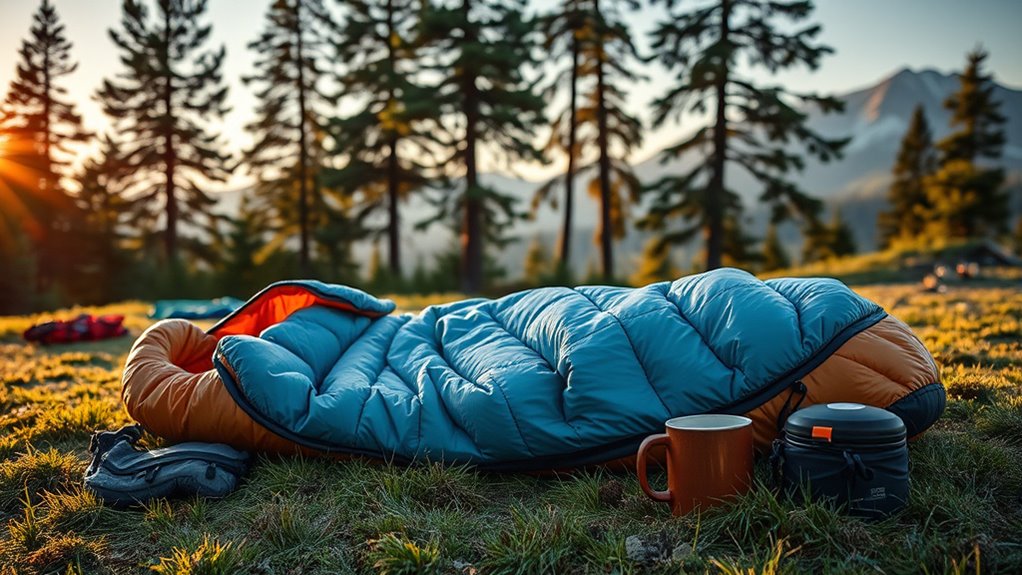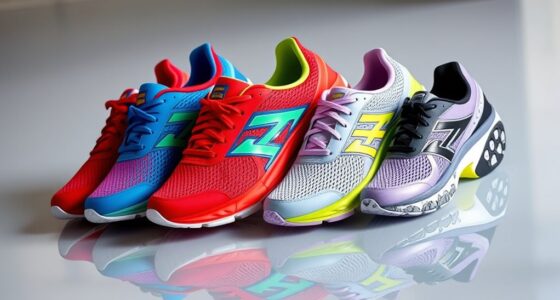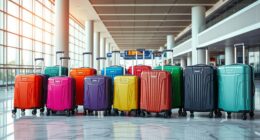If you’re looking for the 15 best backpacking sleeping bags in 2025, I’ve got you covered. I’ve covered options for all seasons, from ultralight models to cold-weather choices, with features like waterproof shells, adjustable fits, and high-quality insulation. Whether you prefer down or synthetic fill, there’s something for everyone. Keep going to discover detailed reviews on these top picks, helping you stay warm and comfortable on your outdoor adventures.
Key Takeaways
- Highlights of top-rated backpacking sleeping bags optimized for warmth, comfort, and packability in 2025.
- Detailed comparisons of insulation types, temperature ratings, and weather resistance features.
- Insights into size options, fit, and design styles for different user needs and preferences.
- Information on durability, materials, weight, and portability for outdoor adventures.
- Additional features like zippers, hoods, eco-friendly fabrics, and compatibility to enhance usability.
VENTURE 4TH Sleeping Bag for Camping and Hiking
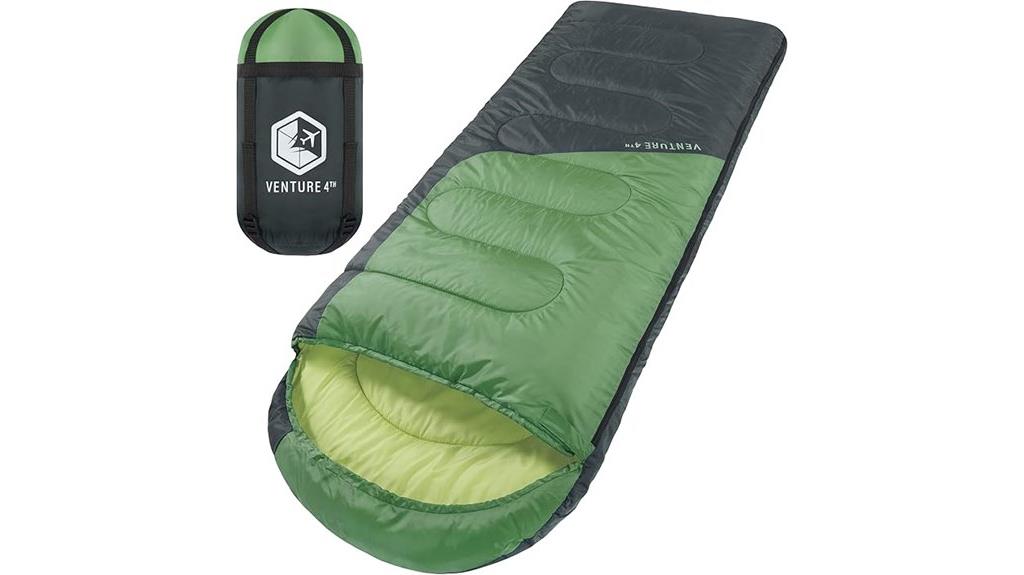
If you’re looking for a versatile sleeping bag that suits adults, kids, or couples, the VENTURE 4TH Backpacking Sleeping Bag is an excellent choice. It comes in XXL, double, and single sizes, perfect for all outdoor adventures like camping, hiking, and trekking. Made from high-quality polyester, it’s lightweight yet durable, with a water-resistant shell. Designed for summer temperatures between 40-80°F, it offers breathable comfort and cozy insulation. With a spacious 86.6 x 31.5-inch design, it comfortably fits campers up to 511 pounds. Plus, each bag undergoes testing and is backed by a lifetime replacement guarantee for peace of mind.
Best For: outdoor enthusiasts, families, and couples seeking a versatile, durable, and comfortable sleeping bag for camping, hiking, or trekking in summer temperatures.
Pros:
- Available in multiple sizes (XXL, double, single) to suit adults, kids, and couples
- Made from high-quality, water-resistant polyester for durability and outdoor resilience
- Lightweight (around 3 pounds) with a compact compression sack for easy transport and storage
Cons:
- Designed primarily for summer temperatures 40-80°F, not suitable for colder conditions
- May be too spacious or lightweight for winter camping needs
- Slightly larger pack size compared to ultra-compact sleeping bags, which might affect packing in tight spaces
PTEROMY Sleeping Bags for Adults
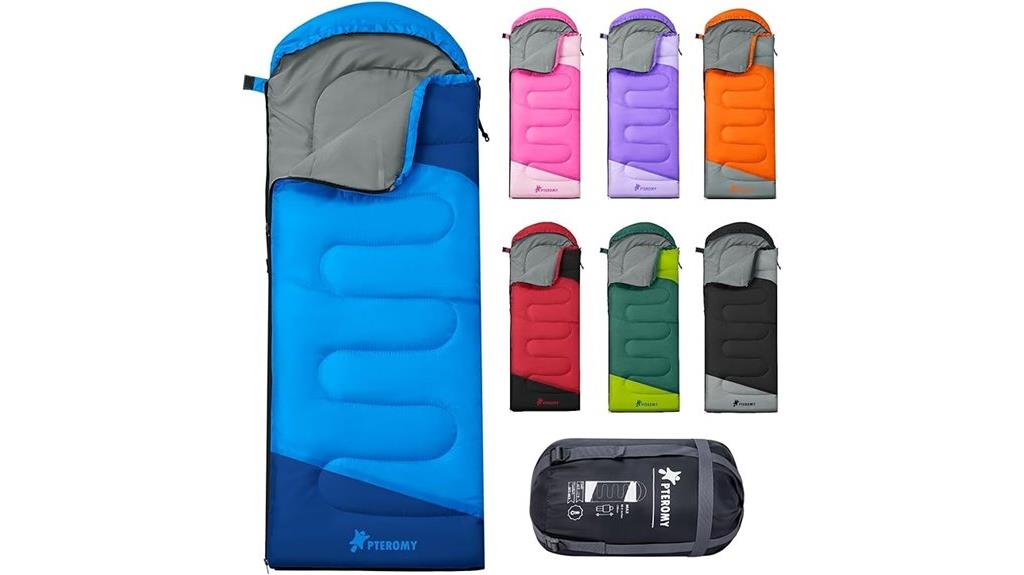
PTEROMY Sleeping Bags for Adults are an excellent choice for outdoor enthusiasts who value lightweight, durable gear that doesn’t compromise on warmth. These bags are water-resistant, windproof, and designed for comfort in cooler temperatures, with a cotton fill and soft spun cotton lining. Measuring 7 feet 2 inches long, they fit adults up to 7 feet tall, and feature adjustable drawstrings, inner pockets, and a bottom ventilation zipper. Weighing just over 3 pounds, they fold into compact sizes for easy transport. Praised for their durability and warmth, they’re perfect for camping, backpacking, or emergency use in mild to cool weather.
Best For: outdoor enthusiasts, campers, and travelers seeking a lightweight, durable, and warm sleeping bag suitable for cool weather conditions.
Pros:
- Lightweight and compact, easy to carry and store
- Water-resistant, windproof, and durable materials ensure long-lasting use
- Comfortable fit for adults up to 7 feet tall with adjustable features
Cons:
- Some users report slight tightness around the shoulders, which can be adjusted but may still be restrictive for some
- Minor issues with threads ripping when pulling on hood strings have been noted
- Designed for cool to mild temperatures, may not be suitable for extreme cold conditions
Sleeping Bags for Adults Backpacking Lightweight Waterproof
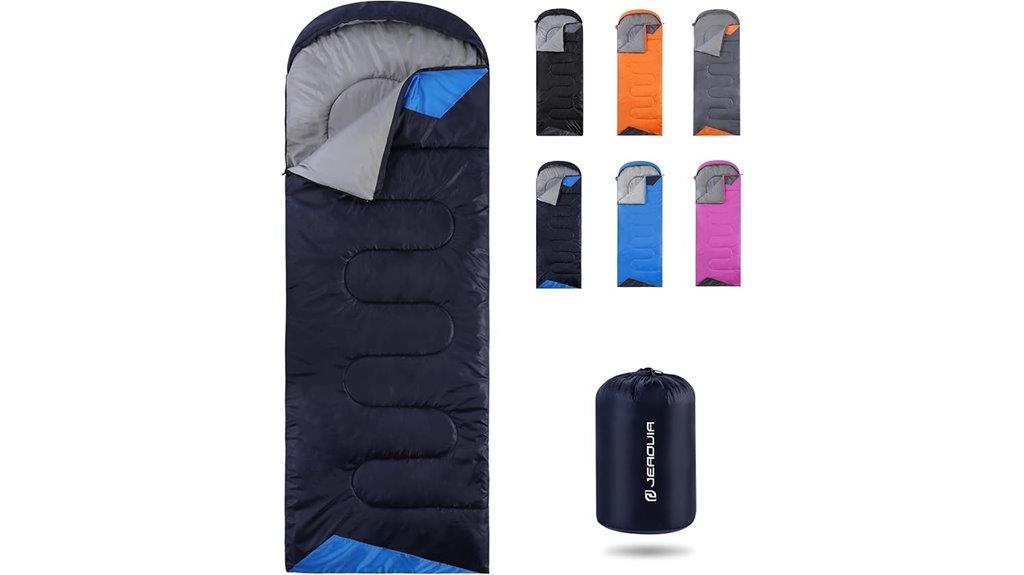
For adult backpackers seeking a reliable and lightweight sleeping solution, this waterproof sleeping bag offers an excellent combination of portability and protection. Weighing just 3.3 pounds and packing down to 14.2 inches, it’s easy to carry on any adventure. Designed for three-season use, it keeps you warm in temperatures from 50℉ to 68℉, with features like a drawstring hood and adjustable zipper for comfort. Made from waterproof, breathable fabrics, it prevents dampness while ensuring breathability. Its durable construction and easy-to-clean materials make it perfect for camping, hiking, or emergency situations, offering comfort and security in various outdoor conditions.
Best For: adult backpackers, campers, and outdoor enthusiasts seeking a lightweight, waterproof sleeping bag for three-season use.
Pros:
- Lightweight and compact, easy to carry with included compression bags
- Waterproof and breathable fabrics prevent dampness and ensure comfort
- Suitable for a wide range of outdoor activities, from camping to emergency situations
Cons:
- Designed for 3-season use, may not be ideal for extreme cold conditions
- Fits individuals up to 5 feet 11 inches, may not accommodate taller users comfortably
- Limited temperature range (50℉-68℉), less suitable for winter camping
Teton 20F and 5F Degree Sleeping Bag, Lightweight Mummy Sleeping Bags

The Teton 20F and 5F Degree Sleeping Bags are ideal choices for backpackers seeking lightweight warmth on their outdoor adventures. These mummy sleeping bags are crafted with microfiber insulation, offering high loft, durability, and easy compression. The design features mummy hoods, vaulted footboxes, and body-mapped insulation to ensure maximum warmth, even down to 5°F. Their lightweight construction includes full-length draft tubes and anti-snag zippers for convenience and efficiency. Suitable for both adults and kids, they’re perfect for camping, hiking, and backpacking trips. Plus, with a compression sack, they’re easy to pack, making them a reliable choice for cold-weather outdoor pursuits.
Best For: backpackers, campers, and outdoor enthusiasts seeking lightweight, warm sleeping solutions for cold weather adventures.
Pros:
- High loft microfiber insulation provides excellent warmth and durability.
- Mummy design with vaulted footboxes and body-mapped insulation maximizes heat retention.
- Lightweight and compact, easily fitting into included compression sacks for portability.
Cons:
- Weighs around 8.2 pounds, which may be heavy for ultra-light backpackers.
- Limited to temperatures down to 5°F, not suitable for extremely cold conditions.
- May require additional layering or gear for comfort in winter or very cold environments.
ZOOOBELIVES Ultralight Down Sleeping Bag (T400)
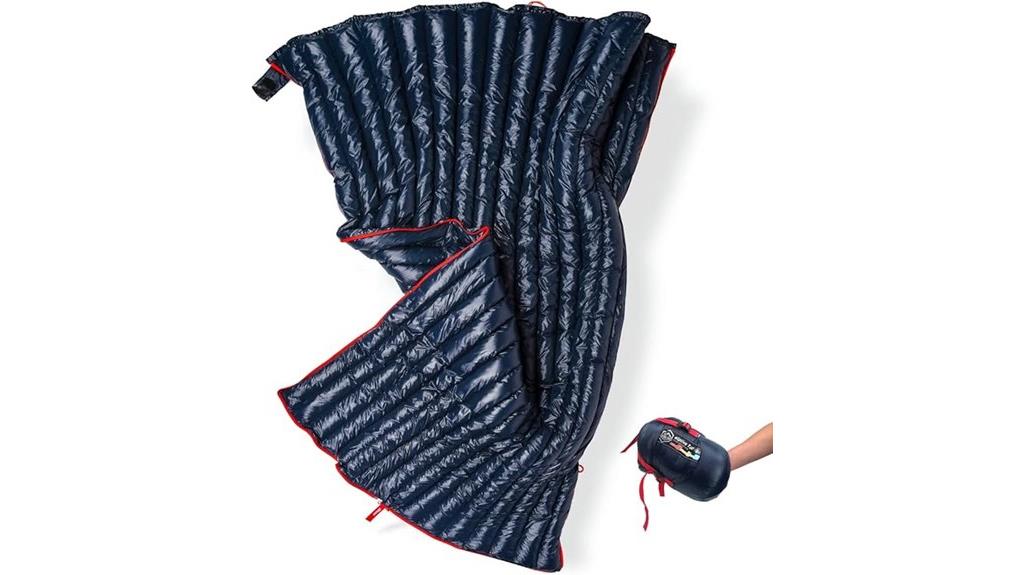
If you’re looking for a lightweight, packable sleeping bag that still keeps you warm in milder conditions, the ZOOOBELIVES Ultralight Down Sleeping Bag (T400) is an excellent choice. Weighing just 1.7 pounds and packing down to 11 x 6.7 inches, it’s perfect for three-season backpacking. Its 650-fill hydrophobic down provides warmth for 32-50°F temperatures, while the water-repellent nylon shell adds durability. The rectangular design offers spaciousness and zip-in options for pairing, and features like dual antisnag YKK zippers make it easy to use. Overall, it’s a versatile, compact bag that delivers comfort and warmth without adding weight to your pack.
Best For: outdoor enthusiasts seeking a lightweight, versatile sleeping bag for mild to moderate temperatures, ideal for summer backpacking, casual camping, and backcountry trips.
Pros:
- Ultra-lightweight at only 1.7 pounds, making it highly portable and easy to pack
- 650-fill hydrophobic down provides excellent warmth-to-weight ratio and moisture resistance
- Features like dual YKK antisnag zippers and zip-in compatibility enhance usability and versatility
Cons:
- Fabric can feel plasticky and may have a slight plastic smell initially
- Limited color options and a somewhat basic aesthetic
- Not suitable for extremely cold conditions below 32°F without additional insulation
Kelty Cosmic 20 Down Mummy Sleeping Bag
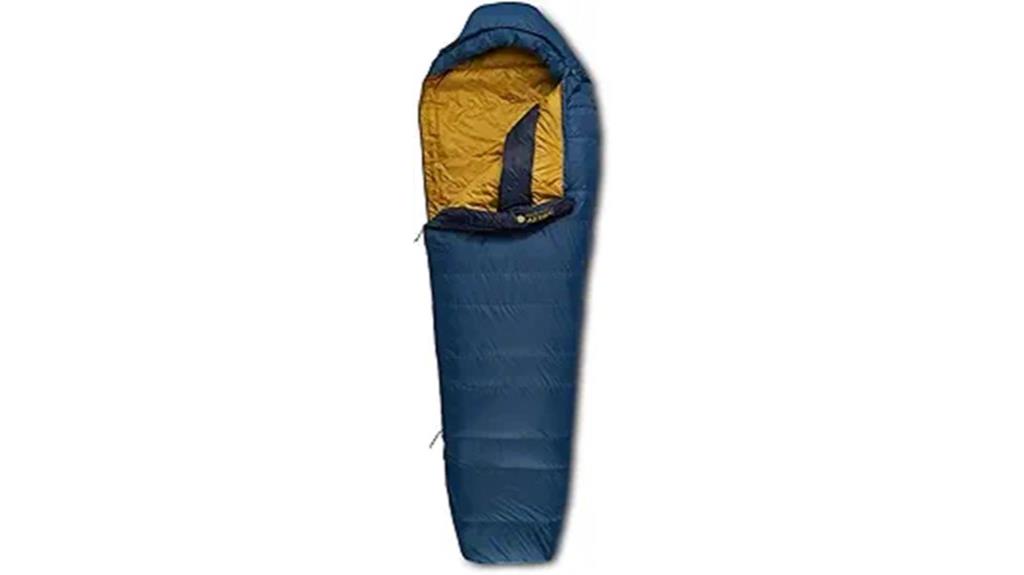
Looking for a reliable sleeping bag that balances warmth, weight, and sustainability? The Kelty Cosmic 20 Down Mummy Sleeping Bag fits the bill perfectly. Designed in Colorado, it’s a versatile three-season option with trapezoidal baffles for better heat retention and an expanded footbox for comfort. Weighing about 2 lbs. 6 oz., it’s lightweight, yet insulated with 550-fill power ethically sourced down, rated for 21°F. Its recycled nylon shell and liner, PFC-free DWR treatment, and eco-friendly construction make it a sustainable choice. With dual zippers, a stash pocket, and a natural fit, it’s a dependable, eco-conscious option for backpackers seeking warmth and comfort.
Best For: unisex adult backpackers and campers seeking a sustainable, warm, and lightweight sleeping bag for three-season outdoor adventures.
Pros:
- Eco-friendly construction with recycled fabrics and ethically sourced down.
- Excellent heat retention due to trapezoidal baffle design and expanded footbox.
- Lightweight at approximately 2 lbs. 6 oz., making it easy to carry on backpacking trips.
Cons:
- Limited to 21°F ISO limit rating, which may not be suitable for extremely cold conditions.
- Slightly bulkier pack size (14.4 x 7.9 x 6.1 inches) compared to ultralight models.
- As a three-season bag, it may not perform well in winter or very cold environments.
Down Sleeping Bag for Adults
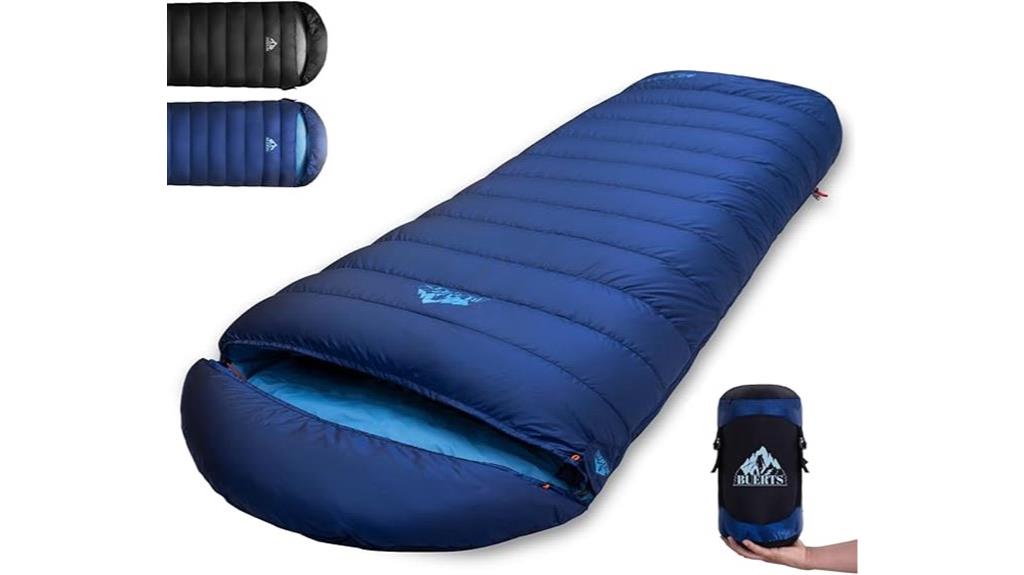
Are you searching for a lightweight sleeping bag that keeps you warm in various outdoor conditions? The BUERTS BSE-B down sleeping bag is a great choice. It weighs just 2.68 pounds and is filled with 21.1 ounces of premium RDS-certified down, offering excellent warmth without bulk. Made of durable 400T 20D nylon, it’s windproof, waterproof, and tear-proof—perfect for rugged adventures. Designed for three-season use, it’s rated for temperatures between 44°F and 32°F, with an extreme limit of 24°F. Features like a compression sack, inner pocket, and zipper options make it versatile and easy to pack, making it ideal for backpacking and outdoor excursions.
Best For: outdoor enthusiasts, campers, and backpackers seeking a lightweight, warm, and durable sleeping bag for three-season use.
Pros:
- Ultralight design with 21.1 oz of premium RDS-certified down for excellent warmth-to-weight ratio
- Durable, windproof, waterproof, and tear-proof nylon fabric suitable for rugged outdoor conditions
- Compact and portable with a compression sack, making it easy to carry and store
Cons:
- Customer ratings are moderate at 3.9 out of 5 stars, indicating mixed reviews on performance or durability
- Limited temperature range for extreme cold (down to 24°F), may not be suitable for very cold winter conditions
- Zipper system allows for double sleeping bags but may be cumbersome or prone to snagging during use
Teton LEEF Lightweight Mummy Sleeping Bag
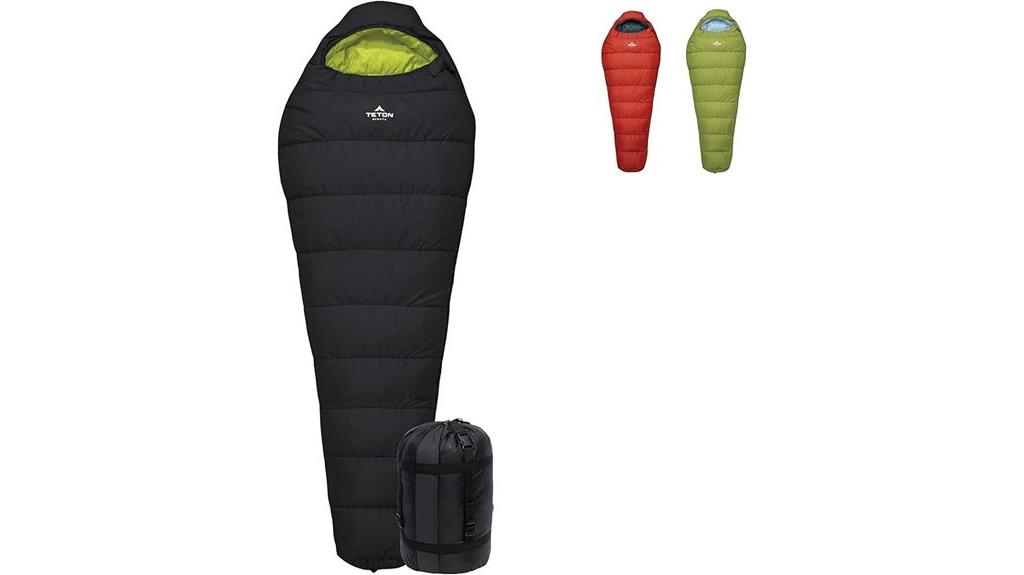
The Teton LEEF Lightweight Mummy Sleeping Bag stands out as an excellent choice for backpackers who need reliable warmth without extra bulk. I love how it’s available in 0°F, 20°F, and 30°F ratings, so I can pick the perfect one for different seasons. Its ultralight design and roomier mummy shape give me warmth and freedom of movement, making it comfortable for long hikes. Plus, it packs down small into a compression sack, which saves space in my backpack. Whether I’m facing chilly nights or milder weather, this sleeping bag offers versatility and dependable performance, backed by Teton Sports’ solid customer support.
Best For: backpackers and outdoor enthusiasts seeking a lightweight, versatile sleeping bag suitable for various weather conditions and long-distance hikes.
Pros:
- Ultralight and compact design for easy packing and transportation
- Available in multiple temperature ratings (0°F, 20°F, 30°F) to suit different climates
- Roomier mummy shape offers comfort and freedom of movement during extended use
Cons:
- May not provide sufficient warmth for extreme cold weather below 0°F
- Limited color options might not appeal to all users
- Slightly higher cost compared to basic sleeping bags with similar features
MalloMe Sleeping Bags for Adults and Kids
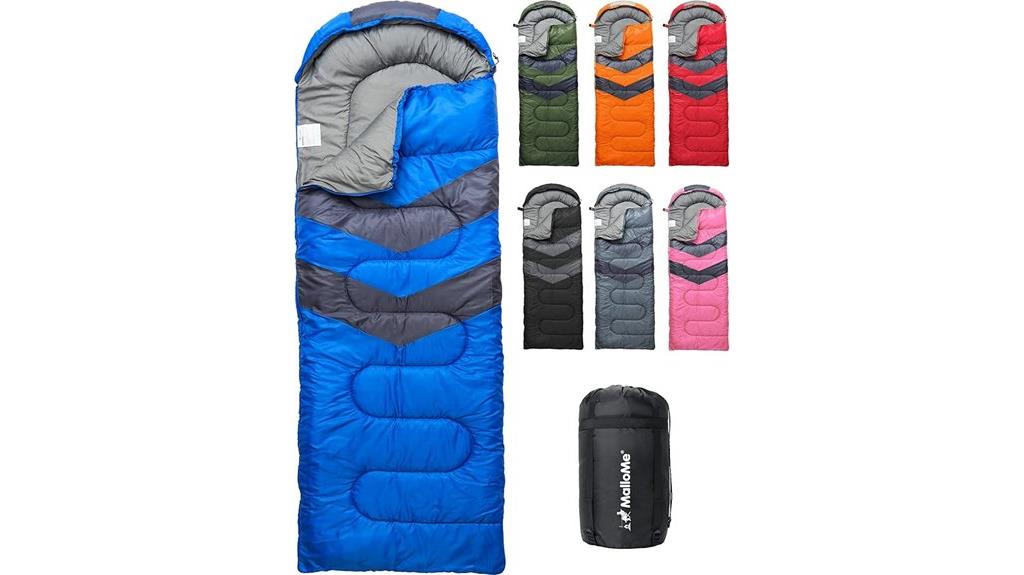
If you’re searching for versatile sleeping bags suitable for both adults and kids, MalloMe Sleeping Bags stand out as an excellent choice. They’re lightweight, around 3 pounds, and come in vibrant colors that appeal to all ages. Designed for year-round use, they handle temperatures from 50°F to 77°F, making them perfect for spring, summer, and fall. The waterproof hex-tech outer shell, combined with double-layered stitching and synthetic insulation, ensures warmth and protection from the elements. Easy to clean and store in a compact compression sack, these bags deliver comfort and practicality for camping, backpacking, or outdoor adventures with the whole family.
Best For: families, campers, and outdoor enthusiasts seeking versatile, comfortable sleeping bags suitable for all ages and various weather conditions.
Pros:
- Lightweight at around 3 pounds, easy to carry and pack
- Suitable for year-round use with temperature ratings from 50°F to 77°F
- Durable, waterproof hex-tech outer shell with easy maintenance and compact storage
Cons:
- May not be ideal for extreme cold conditions below 50°F
- Limited to moderate temperature ranges, not suitable for harsh winter camping
- Some users might find the vibrant colors less subtle for certain preferences
Naturehike Compact Sleeping Bag with Compression Sack
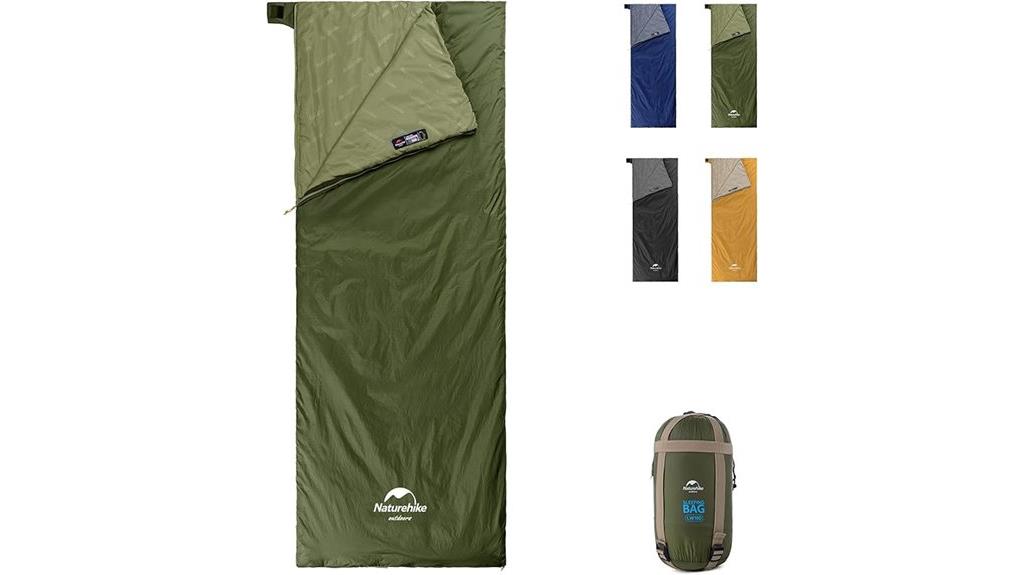
The Naturehike Compact Sleeping Bag with Compression Sack stands out as an ideal choice for hikers and travelers seeking lightweight, space-saving gear without sacrificing comfort. Its compact design compresses to the size of a Nalgene bottle, making it perfect for backpacking, camping, or travel. It fits comfortably for various body sizes, including those around 5’8” and 240 lbs. Made with durable, waterproof outer fabric and breathable inner material, it offers a soft, skin-friendly feel. Versatile enough to use as a blanket or layered for cooler nights, it’s best suited for warm weather, providing reliable comfort above 60°F.
Best For: outdoor enthusiasts and travelers seeking a lightweight, compact sleeping solution suitable for warm weather conditions.
Pros:
- Extremely portable, compresses to the size of a Nalgene bottle for easy packing
- Soft, breathable, and skin-friendly fabric provides a comfortable sleep experience
- Versatile use as a sleeping bag or blanket, ideal for summer nights and mild weather
Cons:
- Designed mainly for warm weather; less effective below 55°F without additional insulation
- Not suitable for cold or winter camping conditions
- Limited insulation, which may not keep users warm in cooler temperatures or high-altitude environments
0 Degree Winter Sleeping Bags for Adults Camping
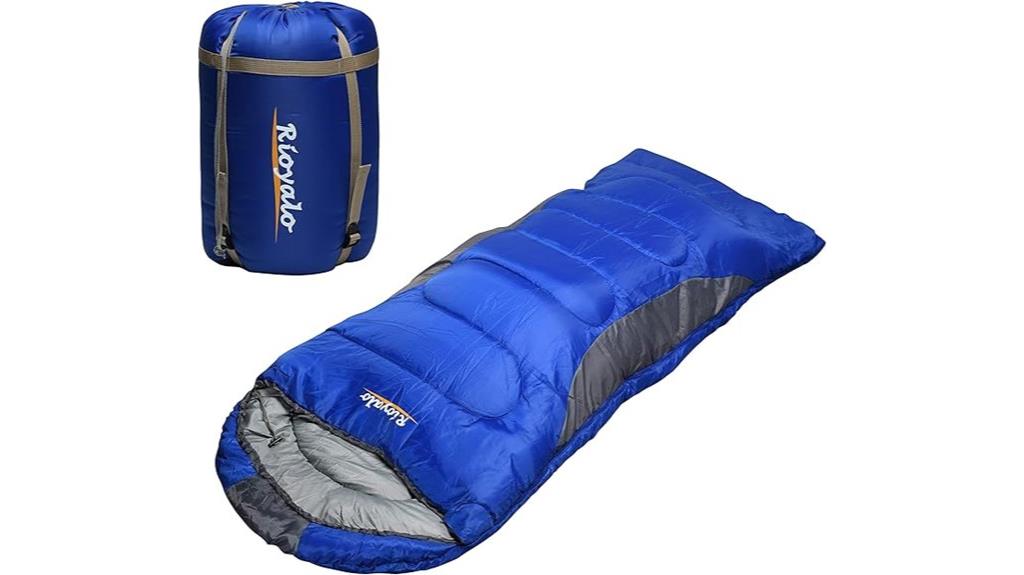
Designed with Big and Tall campers in mind, 0-degree winter sleeping bags provide exceptional warmth and ample space for users up to 6’10”. I appreciate how these bags are made from durable, waterproof microfiber and feature a spacious, envelope hoodie shape, perfect for all seasons. With a temperature rating down to 5°F, they keep extremities warm even in freezing conditions. The silky lining feels great against the skin, and internal pockets add convenience. Weighing as little as 5 pounds, these bags are portable and easy to pack. Overall, they combine comfort, durability, and warmth, making them ideal for cold-weather camping adventures.
Best For: Big and Tall campers seeking a warm, spacious, and durable sleeping bag for all-season outdoor adventures, including cold-weather camping down to 5°F.
Pros:
- Designed with ample space and comfort for users up to 6’10”, accommodating larger individuals comfortably.
- Made from high-quality, waterproof microfiber with excellent insulation, ensuring warmth in freezing conditions.
- Lightweight, portable, and easy to carry with a compression sack, ideal for backpacking and travel.
Cons:
- Slightly tight around the feet for some taller or larger users, possibly requiring size adjustments.
- Material wear may occur after extended use or in extreme cold, such as fraying around zippers.
- May have limited heat retention in extreme winter conditions below 5°F for some users.
Naturehike Mummy Sleeping Bag for Camping and Hiking
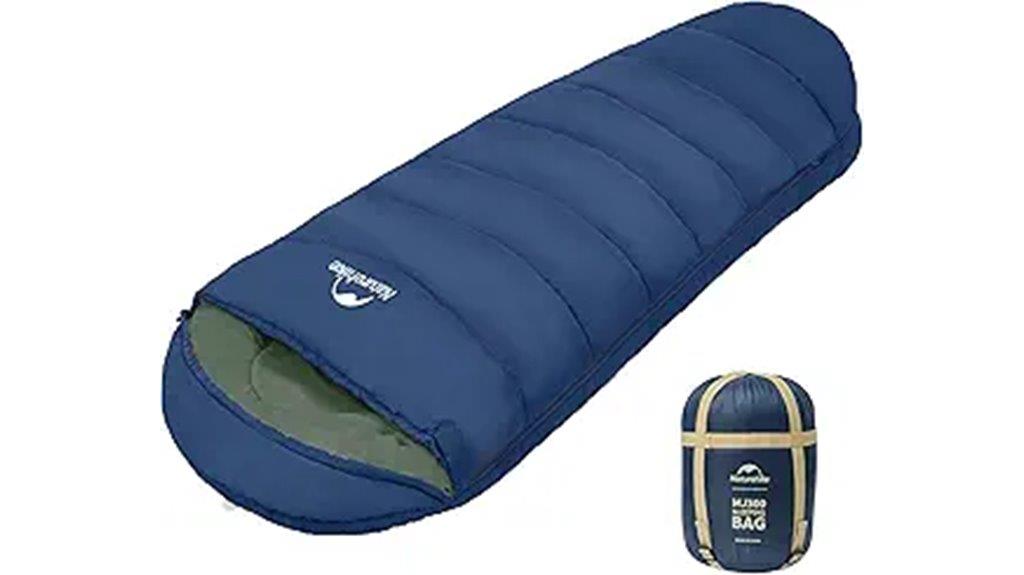
For backpackers seeking reliable warmth in colder conditions, the Naturehike Mummy Sleeping Bag stands out as an excellent choice. It’s designed for spring, fall, and winter adventures, with models like MJ300 (-1°C to 4°C) and MJ600 (-24°C to -5°C) that suit various environments. Made from durable, splash-proof polyester and lined with soft, skin-friendly fabric, it offers comfort and protection. Features like a windproof neck drawstring and hood help trap heat, while its lightweight, compact design makes it easy to carry. With a 1-year warranty and positive reviews, this sleeping bag is a dependable option for serious backpackers.
Best For: Backpackers and outdoor enthusiasts seeking reliable warmth and compact, lightweight sleeping solutions for cold weather camping, hiking, or mountaineering.
Pros:
- Effective insulation with multiple temperature ratings suitable for various cold conditions
- Durable, splash-proof polyester fabric with a soft, skin-friendly lining for comfort and protection
- Compact and lightweight design, easy to pack and carry during backpacking trips
Cons:
- May be less suitable for extremely humid environments due to potential moisture retention in hollow cotton filling
- Limited size options for very tall or larger individuals
- Zippers and closures may require careful handling to prevent snagging or leaks
Teton Celsius Regular Sleeping Bag
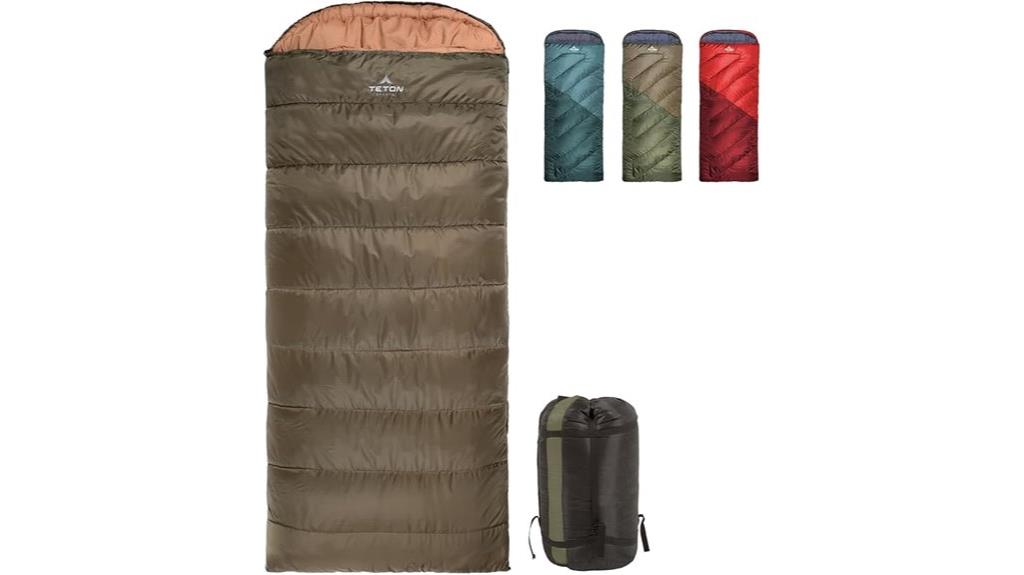
If you’re looking for a versatile sleeping bag that handles all weather conditions, the Teton Celsius Regular sleeping bag is an excellent choice. It’s suitable for both adults and kids, with temperature ratings of -25°F, 20°F, and 0°F, making it perfect for various outdoor adventures. The soft poly-flannel lining adds comfort, and the half-circle mummy hood keeps warmth in while protecting your pillow. Its spacious design allows easy movement, and the double-layer insulation with draft tubes blocks cold air effectively. Plus, it comes with a durable compression sack for easy packing, making it portable without sacrificing warmth or comfort.
Best For: outdoor enthusiasts of all ages seeking a reliable, versatile sleeping bag suitable for various weather conditions and outdoor adventures.
Pros:
- Soft poly-flannel lining for added comfort and coziness
- Effective double-layer insulation with draft tubes for superior warmth retention
- Comes with a durable compression sack for easy portability and storage
Cons:
- May be bulky when packed, despite compression features
- Slightly heavier than ultralight sleeping bags, which could impact backpacking ease
- Limited color options or personalization features
ECOOPRO Warm Weather Sleeping Bag for Camping and Hiking
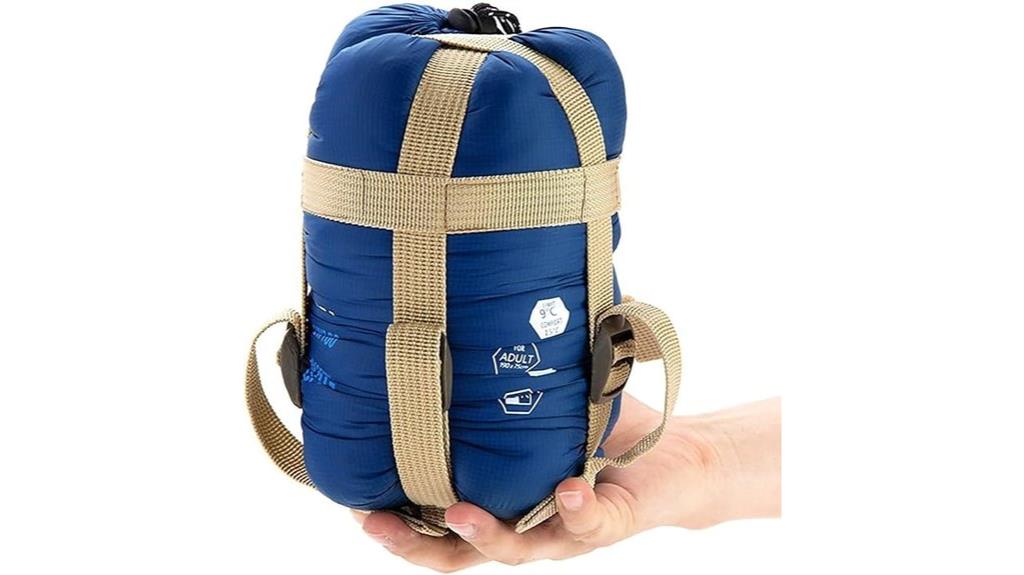
The ECOOPRO Warm Weather Sleeping Bag stands out as an excellent choice for backpackers heading into warm climates, thanks to its lightweight and compact design. Weighing just 1.7 pounds and packing down to 11 inches, it’s easy to carry and store. Made from durable nylon and breathable polyester, it offers comfort for temperatures between 55 and 60℉. Its rectangular shape provides ample room, though larger or curvier users might find it snug. Perfect for summer camping, backpacking, and hiking, it’s quick-drying and portable, with a zipper, hood, and compression sack included. Overall, it’s a solid value for warm-weather outdoor adventures.
Best For: outdoor enthusiasts seeking a lightweight, warm-weather sleeping solution for summer camping, backpacking, and hiking in mild climates.
Pros:
- Lightweight and compact, easy to carry and pack down to 11 inches.
- Made from durable, breathable materials suitable for warm weather.
- Includes useful features like a hood, zipper, and compression sack for convenience.
Cons:
- May be too snug for larger or curvier users, especially around hips and shoulders.
- Not fully waterproof; water resistance may be limited in heavy rain or damp environments.
- Zipper quality and ease of use can vary, with some users experiencing difficulties.
Naturehike Ultralight Down Sleeping Bag
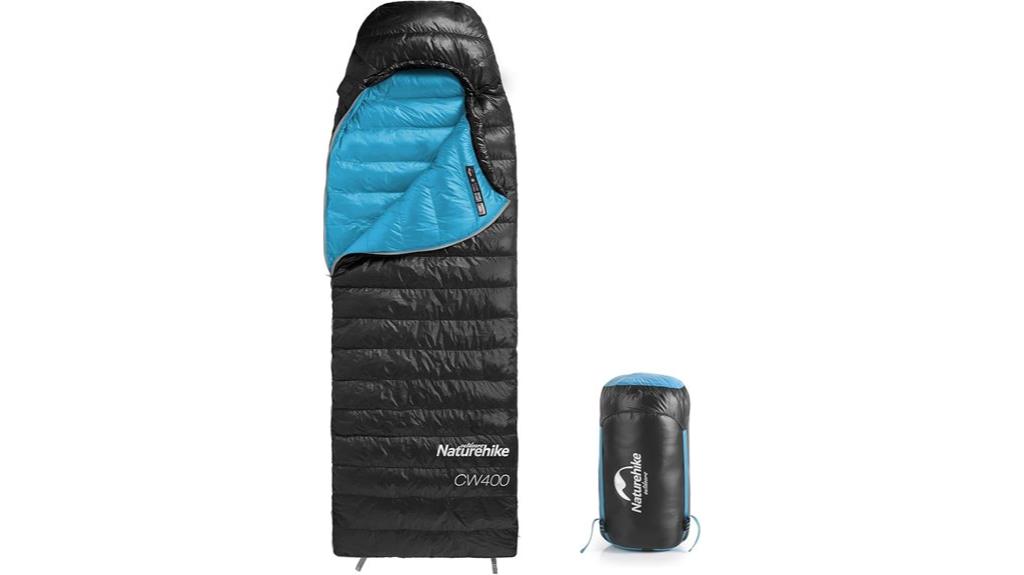
The Naturehike Ultralight Down Sleeping Bag stands out as an ideal choice for backpackers who prioritize lightweight gear without sacrificing warmth and comfort. Its innovative design combines envelope and mummy styles, offering head warmth and better mobility. Filled with high-quality, odorless RDS-certified duck down with 650 fill power, it keeps you warm down to about 40.4℉ (4.7℃). Made with durable, waterproof 400T ripstop nylon, it’s built to last. Weighing just 2 lbs (910g), it’s incredibly portable, fitting into a compact 13.8” x 7.1” sack. Perfect for camping, hiking, and mountaineering, it’s a reliable choice for outdoor adventurers.
Best For: Backpackers and outdoor enthusiasts seeking a lightweight, warm, and durable sleeping bag for camping, hiking, and mountaineering trips.
Pros:
- Ultralight at only 2 lbs, making it easy to carry on extended backpacking adventures
- Combines envelope and mummy styles for optimal warmth and mobility
- Made with high-quality, RDS-certified duck down and durable waterproof nylon for longevity
Cons:
- Comfort temperature of approximately 40.4℉ (4.7℃) may be too cool for colder conditions
- Limited size options may not fit all body types comfortably
- Not suitable for sub-zero temperatures or harsh winter camping
Factors to Consider When Choosing Backpacking Sleeping Bags
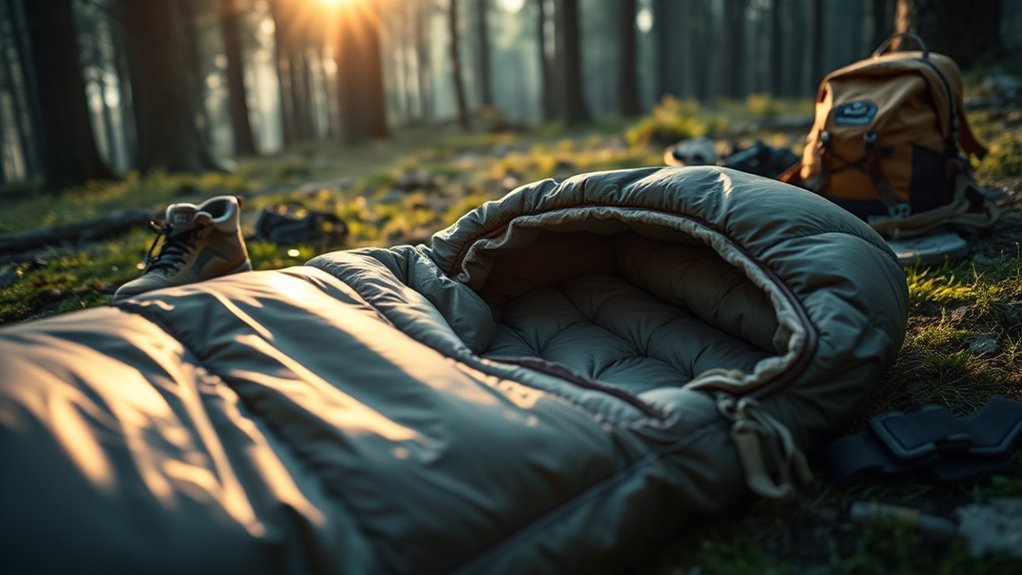
When choosing a backpacking sleeping bag, I focus on key factors like temperature ratings to keep me warm, and weight and packability for easy carrying. I also consider material durability to guarantee it lasts, along with size and fit for comfort. Finally, weather resistance is vital to stay dry and cozy in unpredictable conditions.
Temperature Ratings
Understanding temperature ratings is essential when choosing a backpacking sleeping bag because they directly indicate how well the bag will keep you warm in various conditions. These ratings are typically categorized as comfort, limit, and extreme. Comfort ratings are for typical sleepers to stay warm and comfortable, while limit ratings show the minimum temperature for survival without discomfort. Extreme ratings serve as safety margins, indicating temperatures where prolonged exposure could risk hypothermia. Different bags are rated for specific ranges, such as 0°F for winter or 50-68°F for summer. I always recommend selecting a bag with a rating at least 10°F lower than the coldest weather you expect. This ensures you stay warm, safe, and comfortable during your trip.
Weight and Packability
Choosing a backpacking sleeping bag involves considering weight and packability because these factors directly impact how comfortably and efficiently you can carry your gear on long trips. Lighter bags, usually under 3 pounds, make it easier to manage extended hikes without adding strain. Compressibility is key; bags that come with compression sacks can be packed down small, freeing up space in your pack. The material and design also matter—ultralight fabrics like nylon help keep weight down without sacrificing durability. Versatile bags that double as blankets or quilts can reduce the need for extra gear, saving space and weight. Always consider both the packed size and weight to ensure your sleeping bag fits your overall gear limits and makes your trip more enjoyable.
Material Durability
Material durability is a essential factor because it determines how well a sleeping bag withstands the rigors of outdoor use. I look for bags made from high-quality fabrics like ripstop nylon, polyester, or nylon blends, which resist tearing and abrasion. Reinforced stitching along seams and zippers adds strength, preventing fraying during tough conditions. A water-resistant or water-repellent outer shell protects against moisture, extending the bag’s lifespan. Higher denier fabrics, such as 20D or 30D, tend to be more resilient than lower denier options, which wear out faster. Proper maintenance also matters; cleaning and storing the bag uncompressed in a cool, dry place help preserve its material integrity. Overall, investing in durable materials ensures my sleeping bag stays reliable season after season.
Size and Fit
Selecting the right size and fit for a backpacking sleeping bag is key to staying comfortable and warm on your trips. I recommend choosing a bag that’s at least 6-12 inches longer than your height to allow for comfortable movement and layering. The shape matters too—mummy bags trap heat efficiently, while rectangular ones offer more space for freedom of movement. Make sure the fit around your shoulders, hips, and feet isn’t too tight or too loose, as either can compromise comfort and insulation. Check internal volume to ensure it suits your body size, especially if you’re taller or larger. Additionally, look for adjustable features like drawstrings or customizable hoods to fine-tune the fit and maximize warmth. A well-fitting bag makes all the difference in your outdoor experience.
Weather Resistance
When it comes to weather resistance, paying attention to the outer shell of your backpacking sleeping bag is essential because it determines how well the bag can withstand rain, dew, and humidity. I look for bags with water-resistant or waterproof shells, like nylon with a DWR coating, to prevent moisture from seeping in during unexpected showers or damp mornings. Sealed or taped seams are also a must—they keep moisture out and preserve insulation in damp conditions. Inside, moisture-wicking liners like polyester or pongee fabrics help reduce dampness from sweat and humidity. Ventilation features, such as zippers at the foot or adjustable hoods, allow me to regulate humidity and prevent internal condensation. A high-quality, water-resistant shell combined with appropriate temperature ratings ensures reliable performance in unpredictable weather.
Insulation Type
The type of insulation in your backpacking sleeping bag substantially influences its performance in various weather conditions. Down insulation offers an exceptional warmth-to-weight ratio and is highly compressible, making it ideal for lightweight packing. However, it requires careful moisture management because wet down clumps and loses loft, reducing its insulating power. Synthetic insulation, on the other hand, maintains its warmth even when damp, making it better suited for humid or wet environments. Hybrid options combine both materials to balance warmth, weight, and moisture resistance, offering versatile performance. Your choice impacts key factors like temperature rating, packability, durability, and suitability for different conditions. Understanding these differences helps you select a sleeping bag that best matches your outdoor needs and ensures comfort on your backpacking adventures.
Budget Considerations
Are you trying to get the best value when choosing a backpacking sleeping bag? If so, it’s important to compare costs alongside features like insulation type, temperature ratings, and durability. Affordable options often use synthetic fills and cheaper outer materials, which can affect longevity and warmth compared to higher-end down or premium fabrics. Setting a clear budget helps narrow your choices, but don’t sacrifice essential features like water resistance, weight, and packability. Keep in mind that cheaper sleeping bags may be suitable for mild weather, but investing a bit more can give you better insulation and durability for colder or rugged conditions. Beware of extremely cheap options—they may save money upfront but often lead to higher replacement costs due to wear and tear over time.
Frequently Asked Questions
How Do Sleeping Bags Perform in Extreme Weather Conditions?
Sleeping bags designed for extreme weather conditions are built to perform well in those harsh environments. I find that insulated, weather-resistant bags keep me warm and dry, even in freezing temperatures or heavy rain. They often feature high-quality down or synthetic fill and robust shells. To stay comfortable, I always choose a bag rated for the expected conditions and layer appropriately. Proper gear truly makes a difference in extreme weather adventures.
What Are the Best Materials for Durability and Insulation?
I’ve found that durable materials like ripstop nylon and polyester are my go-to for toughness, while down and synthetic fills provide excellent insulation. It’s funny how I once trusted just synthetic, but then I realized that down offers better warmth-to-weight ratio, especially in cold weather. Combining tough outer shells with high-quality insulation makes my sleeping bag both resilient and cozy, perfect for unpredictable adventures.
How Important Is Weight Versus Warmth in Backpacking Sleeping Bags?
Weight and warmth both matter, but I prioritize warmth because staying warm keeps me safe and comfortable. A lightweight bag is great, but if it doesn’t provide enough insulation, I’ll struggle in cold conditions. I look for a balance—light enough to carry easily, but warm enough for my planned weather. Ultimately, I choose a sleeping bag that keeps me cozy without adding unnecessary weight.
Can Sleeping Bags Be Used for Winter Camping?
Yes, sleeping bags can be used for winter camping, but you need the right one. I once tried camping in freezing temperatures with a summer bag—let’s just say I felt like a popsicle! For winter, I recommend a four-season or expedition bag with high insulation. Think of it as wrapping yourself in a warm blanket inside a cozy cabin—essential for staying warm and safe in harsh winter conditions.
How Do Different Shapes Affect Comfort and Packing Efficiency?
Different shapes of sleeping bags markedly impact comfort and packing efficiency. Mummy bags, for example, are more thermally efficient and compact, making them great for cold weather and backpacking. Rectangular bags offer more room to move, providing extra comfort but take up more space. Semi-rectangular designs strike a balance, combining warmth with packability. I choose my bag shape based on my trip’s weather and how much space I want to save.
Conclusion
Choosing the right backpacking sleeping bag is like finding a trusted companion on a wild adventure—it keeps you safe, warm, and ready for whatever comes next. Whether you prioritize lightweight design or maximum warmth, the right bag can transform your outdoor experience into a cozy journey through the stars. So, pick your partner wisely, and let it cradle you through every night under the open sky, turning dreams into unforgettable memories.

